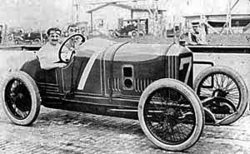Difference between revisions of "Georges Boillot"
m |
m |
||
| Line 7: | Line 7: | ||
That same year, his Peugeot teammate, Jules Goux became the first Frenchman to win the [[Indianapolis 500]] in the [[United States]]. The following year the French sent a number of competitors to the [[Indiana]] speedway where on May 27, during qualification runs, Georges Boillot came tantalizing close to breaking the 100 mile-an-hour barrier when he set a new speed record of 99.860 mph. Much faster than any other driver, Boillot would most likely have won the race with ease had it not been for repeated tire trouble. He ended up finishing 14th while his fellow Frenchmen finished in the top four positions with [[René Thomas]] getting the win. | That same year, his Peugeot teammate, Jules Goux became the first Frenchman to win the [[Indianapolis 500]] in the [[United States]]. The following year the French sent a number of competitors to the [[Indiana]] speedway where on May 27, during qualification runs, Georges Boillot came tantalizing close to breaking the 100 mile-an-hour barrier when he set a new speed record of 99.860 mph. Much faster than any other driver, Boillot would most likely have won the race with ease had it not been for repeated tire trouble. He ended up finishing 14th while his fellow Frenchmen finished in the top four positions with [[René Thomas]] getting the win. | ||
| − | [[Image:Boillot1914Indy.jpg|thumb|left]] | + | [[Image:Boillot1914Indy.jpg|thumb|left|250px]] |
In what would turn out to be his last race, in the 1914 French Grand Prix, at [[Lyon]], his Peugeot was literally falling apart at the end. After demonstrating his tremendous skills by keeping the vehicle running and near the lead, it finally overheated on the last lap and he was forced to retire from the race. | In what would turn out to be his last race, in the 1914 French Grand Prix, at [[Lyon]], his Peugeot was literally falling apart at the end. After demonstrating his tremendous skills by keeping the vehicle running and near the lead, it finally overheated on the last lap and he was forced to retire from the race. | ||
Revision as of 20:57, 4 August 2007
Georges Boillot, born August 3, 1884 – died April 21, 1916, was a French Grand Prix motor racing driver and World War I fighter pilot.
An engineer by profession, Boillot began automobile racing in 1906 and went on to join drivers Paul Zuccarelli and Jules Goux to build their own car as part of the Peugeot team. He debuted with them in 1909 in the Coupe de l'Auto at Rambouillet and in 1910, went to Italy to compete in the Targa Florio
At Dieppe, France, on June 26, 1912, Georges Boillot won the French Grand Prix, in his Peugeot L76, a vehicle designed by the young Italian, Ettore Bugatti. This was the first motorcar in the world to have an engine with four camshafts and four valves per cylinder. Boillot won the Coupe de l'Auto in 1913 and became the darling of French racing fans when he won his second straight French Grand Prix at Amiens.
That same year, his Peugeot teammate, Jules Goux became the first Frenchman to win the Indianapolis 500 in the United States. The following year the French sent a number of competitors to the Indiana speedway where on May 27, during qualification runs, Georges Boillot came tantalizing close to breaking the 100 mile-an-hour barrier when he set a new speed record of 99.860 mph. Much faster than any other driver, Boillot would most likely have won the race with ease had it not been for repeated tire trouble. He ended up finishing 14th while his fellow Frenchmen finished in the top four positions with René Thomas getting the win.
In what would turn out to be his last race, in the 1914 French Grand Prix, at Lyon, his Peugeot was literally falling apart at the end. After demonstrating his tremendous skills by keeping the vehicle running and near the lead, it finally overheated on the last lap and he was forced to retire from the race.
With the outbreak of World War I, Georges Boillot joined the new French Air Force. He lost his life on April 21, 1916 when his plane was shot down in a dogfight over Verdun-sur-Meuse. In his honor, several places in France named a street for him and there is a George Boillot School in Montlhéry in the Essonne département near Paris.
His brother André Boillot was also a race driver and at war's end, won the 1919 Targa Florio. Georges Boillot's son, Jean Boillot, became the director-general of Peugeot Talbot cars and in 1981 was responsible for involving Peugeot into rally racing.
